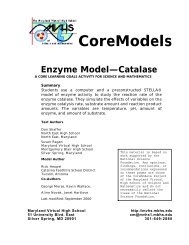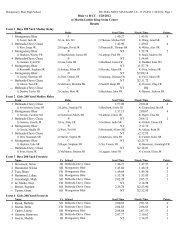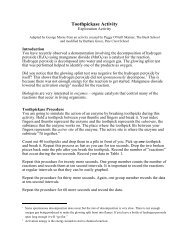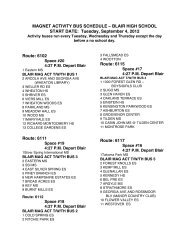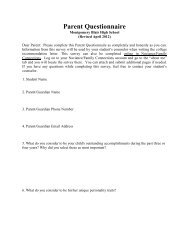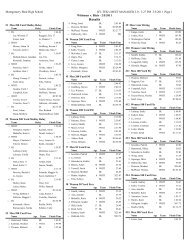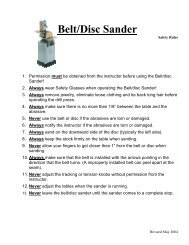The Structure and Function of Enzymes MODULE 1 MODULE 2 ...
The Structure and Function of Enzymes MODULE 1 MODULE 2 ...
The Structure and Function of Enzymes MODULE 1 MODULE 2 ...
You also want an ePaper? Increase the reach of your titles
YUMPU automatically turns print PDFs into web optimized ePapers that Google loves.
<strong>The</strong> <strong>Structure</strong> <strong>and</strong><strong>Function</strong> <strong>of</strong> <strong>Enzymes</strong><strong>MODULE</strong> 1 <strong>MODULE</strong> 2 <strong>MODULE</strong> 3EngagementWhat areenzymes made<strong>of</strong>?What doenzymes do <strong>and</strong>how do they doit?What affectsthe function<strong>of</strong> an enzyme?ExplorationLabinvestigation"Toothpickase"simulationLabinvestigationEvaluation Extension ExplanationPost-labdiscussionGeneticmutationresearchCase scenarioabstractsPost-labdiscussionPractical uses<strong>of</strong> enzymesPracticalapplicationabstractsPost-labdiscussionSTELLA EnzymeModelAssessmentbased on AAAS<strong>and</strong> Maryl<strong>and</strong>st<strong>and</strong>ards1
<strong>The</strong> <strong>Structure</strong> <strong>and</strong> <strong>Function</strong> <strong>of</strong> <strong>Enzymes</strong>Title <strong>of</strong> unit:Unit goal:<strong>The</strong> <strong>Structure</strong> <strong>and</strong> <strong>Function</strong> <strong>of</strong> <strong>Enzymes</strong>Students develop an underst<strong>and</strong>ing <strong>of</strong> the importance <strong>of</strong> enzymes to theirsurvival <strong>and</strong> in their daily lives.Grade Level: 9 – 12General Subject Area: BiologyMinimum time required for the unit:Eight 45-minute class periodsConcepts learned across all unit modules:• Basic enzyme structure <strong>and</strong> function• Experimental design• Data organization• Data analysisSt<strong>and</strong>ards addressed by unit modulesMaryl<strong>and</strong> State Department <strong>of</strong> Education High School Science Core Learning Goals(see www.mdk12.org)Goal/Expectation Indicator/Assessment LimitGoal 1 <strong>The</strong> student will demonstrate ways <strong>of</strong> thinking <strong>and</strong> acting inherent in thepractice <strong>of</strong> science. <strong>The</strong> student will use the language <strong>and</strong> instruments <strong>of</strong>science to collect, organize, interpret, calculate, <strong>and</strong> communicateinformation.1.2 <strong>The</strong> student will pose scientific questions <strong>and</strong> suggest experimentalapproaches to provide answers to questions.1.2.7 <strong>The</strong> student will use relationships discovered in the lab to explainphenomena observed outside the laboratory.1.3 <strong>The</strong> student will carry out scientific investigations effectively <strong>and</strong> employ theinstruments, systems <strong>of</strong> measurement, <strong>and</strong> materials <strong>of</strong> scienceappropriately.1.3.1 <strong>The</strong> student will develop <strong>and</strong> demonstrate skills in using lab <strong>and</strong> fieldequipment to perform investigative techniques.1.3.2 <strong>The</strong> student will recognize safe laboratory procedures.1.3.3 <strong>The</strong> student will demonstrate safe h<strong>and</strong>ling <strong>of</strong> the chemicals <strong>and</strong> materials<strong>of</strong> science.1.4 <strong>The</strong> student will demonstrate that data analysis is a vital aspect <strong>of</strong> theprocess <strong>of</strong> scientific inquiry <strong>and</strong> communication.1.4.1 <strong>The</strong> student will organize data appropriately using techniques such astables, graphs, <strong>and</strong> webs. (for graphs: axes labeled with appropriatequantities, appropriate units on axes, axes labeled with appropriateintervals, independent <strong>and</strong> dependent variables on correct axes,appropriate title)1.4.2 <strong>The</strong> student will analyze data to make predictions, decisions, or drawconclusions.2
1.4.6 <strong>The</strong> student will describe trends revealed by data.1.4.8 <strong>The</strong> student will use models <strong>and</strong> computer simulations to extend his/herunderst<strong>and</strong>ing <strong>of</strong> scientific concepts.1.4.9 <strong>The</strong> student will use analyzed data to confirm, modify, or reject anhypothesis.1.5 <strong>The</strong> student will use appropriate methods for communicating in writing <strong>and</strong>orally the processes <strong>and</strong> results <strong>of</strong> scientific investigation.1.5.1 <strong>The</strong> student will demonstrate the ability to summarize data.1.5.2 <strong>The</strong> student will explain scientific concepts <strong>and</strong> processes through drawing,writing, <strong>and</strong>/or oral communication.1.5.3 <strong>The</strong> student will use computers to produce the visual materials (tables,graphs) that will be used for communicating results.1.5.5 <strong>The</strong> student will use computers to produce tables, graphs, <strong>and</strong> spreadsheetcalculations.1.6 <strong>The</strong> student will use mathematical processes.1.6.1 <strong>The</strong> student will use ratio <strong>and</strong> proportion in appropriate situations to solveproblems.1.6.2 <strong>The</strong> student will use computers to perform calculations for tables <strong>and</strong>graphs.1.6.3 <strong>The</strong> student will express <strong>and</strong>/or compare small <strong>and</strong> large quantities usingscientific notation <strong>and</strong> relative order <strong>of</strong> magnitude.1.7 <strong>The</strong> student will show that connections exist both within the various fields <strong>of</strong>science <strong>and</strong> among science <strong>and</strong> other disciplines including mathematics,social studies, language arts, fine arts, <strong>and</strong> technology.1.7.4 <strong>The</strong> student will recognize mathematics as an integral part <strong>of</strong> the scientificprocess.3
Goal 3 <strong>The</strong> student will demonstrate the ability to use the scientific skills <strong>and</strong>process <strong>and</strong> major biological concepts to explain the uniqueness <strong>and</strong>interdependence <strong>of</strong> living organisms, their interactions with theenvironment, <strong>and</strong> the continuation <strong>of</strong> life on earth.3.1 <strong>The</strong> student will be able to explain the correlation between the structure <strong>and</strong>function <strong>of</strong> biologically important molecules <strong>and</strong> their relationship to cellprocesses.3.1.1 <strong>The</strong> student will be able to describe the unique characteristics <strong>of</strong> chemicalcompounds <strong>and</strong> macromolecules utilized by living systems. [structural <strong>and</strong>functional role <strong>of</strong> enzymes]3.1.2 <strong>The</strong> student will be able to discuss factors involved in the regulation <strong>of</strong>chemical activity as part <strong>of</strong> a homeostatic mechanism [enzyme regulation:effect <strong>of</strong> temperature on enzyme activity]3.2 <strong>The</strong> student will demonstrate an underst<strong>and</strong>ing that all organisms arecomposed <strong>of</strong> cells which can function independently or as part <strong>of</strong>multicellular organisms.3.2.2 <strong>The</strong> student will conclude that cells exist within a narrow range <strong>of</strong>environmental conditions <strong>and</strong> changes to that environment, either naturallyoccurring or induced, may cause death <strong>of</strong> the cell or organism. (pH)3.3 <strong>The</strong> student will analyze how traits are inherited <strong>and</strong> passed on from onegeneration to another3..3.4 <strong>The</strong> student will interpret how the effect <strong>of</strong> gene alteration through naturalor technological advances may have beneficial or harmful effects on theindividual, society, <strong>and</strong>/or environment [mutations]Technology needed in unit modulesSTELLA s<strong>of</strong>tware, Inspiration s<strong>of</strong>tware, <strong>and</strong> Internet access are needed. Graphingcalculators <strong>and</strong> CBL probes can supplement some <strong>of</strong> the activities.Technology-enhanced instructional strategies employedStudents participate in telecollaboration <strong>and</strong> telecommunication to review theirwork <strong>and</strong> receive prompt feedback on their work. Inspiration is used to accessprior knowledge during engagement activities <strong>and</strong> organize information during theexplanation phases <strong>of</strong> instruction. STELLA computer s<strong>of</strong>tware exposes students tosystems dynamics thinking <strong>and</strong> computer modeling.Title <strong>of</strong> Each Module:Module 1: What Are <strong>Enzymes</strong> Made Of?Module 2: What Do <strong>Enzymes</strong> Do <strong>and</strong> How Do <strong>The</strong>y Do It?Module 3: What Affects the <strong>Function</strong> <strong>of</strong> An Enzyme?Unit Culminating Activity:<strong>Enzymes</strong> are usually studied as part <strong>of</strong> a larger unit, biochemistry. <strong>The</strong> unitculminating activity should be the integration <strong>of</strong> application or higher orderquestions on the biochemistry test or project.Unit Author: George L. Morse4
<strong>MODULE</strong> #1Module Title: What Are <strong>Enzymes</strong> Made Of?Estimated time to complete: 90 minutesModule objectives:• Distinguish between an experimental control <strong>and</strong> a variable.• Distinguish between an observation <strong>and</strong> an inference.• Identify the characteristics <strong>of</strong> an enzyme.• Identify the general relationship between genes <strong>and</strong> proteins/enzymes.Concepts learned in this module:• Students develop an underst<strong>and</strong>ing <strong>of</strong> qualitative testing.• Students construct a conceptual underst<strong>and</strong>ing <strong>of</strong> protein structure.• Students develop an underst<strong>and</strong>ing <strong>of</strong> the interrelationships among organic molecules.St<strong>and</strong>ards addressed in this module:Maryl<strong>and</strong> State Department <strong>of</strong> Education High School Science Core Learning GoalsGoal/Expectation Indicator/Assessment LimitGoal 1 <strong>The</strong> student will demonstrate ways <strong>of</strong> thinking <strong>and</strong> acting inherent in thepractice <strong>of</strong> science. <strong>The</strong> student will use the language <strong>and</strong> instruments <strong>of</strong>science to collect, organize, interpret, calculate, <strong>and</strong> communicateinformation.1.4 <strong>The</strong> student will demonstrate that data analysis is a vital aspect <strong>of</strong> theprocess <strong>of</strong> scientific inquiry <strong>and</strong> communication.1.4.1 <strong>The</strong> student will organize data appropriately using techniques such astables, graphs, <strong>and</strong> webs.1.4.2 <strong>The</strong> student will analyze data to make predictions, decisions, or drawconclusions.1.5 <strong>The</strong> student will use appropriate methods for communicating in writing <strong>and</strong>orally the processes <strong>and</strong> results <strong>of</strong> scientific investigation.1.5.1 <strong>The</strong> student will demonstrate the ability to summarize dataGoal 3 <strong>The</strong> student will demonstrate the ability to use the scientific skills <strong>and</strong>process <strong>and</strong> major biological concepts to explain the uniqueness <strong>and</strong>interdependence <strong>of</strong> living organisms, their interactions with theenvironment, <strong>and</strong> the continuation <strong>of</strong> life on earth.3.1 <strong>The</strong> student will be able to explain the correlation between the structure <strong>and</strong>function <strong>of</strong> biologically important molecules <strong>and</strong> their relationship to cellprocesses.3.1.1 <strong>The</strong> student will be able to describe the unique characteristics <strong>of</strong> chemicalcompounds <strong>and</strong> macromolecules utilized by living systems. [structural <strong>and</strong>functional role <strong>of</strong> enzymes]3.1.2 <strong>The</strong> student will be able to discuss factors involved in the regulation <strong>of</strong>chemical activity as part <strong>of</strong> a homeostatic mechanism [enzyme regulation:effect <strong>of</strong> temperature on enzyme activity]5
St<strong>and</strong>ards (continued)3.3 <strong>The</strong> student will analyze how traits are inherited <strong>and</strong> passed on from onegeneration to another.3.3.4 <strong>The</strong> student will interpret how the effect <strong>of</strong> gene alteration through naturalor technological advances may have beneficial or harmful effects on theindividual, society, <strong>and</strong>/or environment [mutations]Technology-enhanced instructional strategies utilized in this module: Web-basedresearch, telecommunication, <strong>and</strong> Inspiration s<strong>of</strong>tware (brainstorming) are used in thisactivity.<strong>MODULE</strong> OVERVIEWComponents Brief description <strong>of</strong> module activities StudentGroupingEngagement Brief brainstorming session to assess <strong>and</strong> Whole classaccess student prior knowledge.Materials/TechnologyInspirations<strong>of</strong>twareExploration Lab investigation involving gelatin, fresh Small grouppineapple, cooked pineapple, <strong>and</strong> meattenderizerExplanation Post lab Whole class Inspirations<strong>of</strong>twareExtension/ElaborationEvaluationProblem-based learning utilizing webbasedresearchLab questions, product <strong>of</strong> the web-basedresearch, <strong>and</strong>/or Blackboard quizIndividualIndividualWWWBlackboardExpected module outcomes: <strong>The</strong> student will:• Construct a basis for distinguishing controls from variables in an experiment;• Distinguish between what is observed <strong>and</strong> what is inferred from those observations,noting that different inferences can be logically made from the same observations;• Identify the effect that cooking foods has on the proteins contained in those foods;• Begin to construct a basis for underst<strong>and</strong>ing molecular biology.Performance-based assessment <strong>of</strong> module outcomes:• Students use data collected during laboratory observations to make inferences aboutenzymes.• Students demonstrate an awareness <strong>of</strong> the importance <strong>of</strong> enzymes <strong>and</strong> proteins to theirhealth by researching <strong>and</strong> writing abstracts based on case scenarios.6
<strong>MODULE</strong> #2Module Title: What Do <strong>Enzymes</strong> Do <strong>and</strong> How Do <strong>The</strong>y Do It?Estimated time to complete: Two 45-minute class periodsModule objectives:Upon successful completion <strong>of</strong> this module the student shall:• Identify the components <strong>of</strong> an enzyme.• Identify factors that affect the rate <strong>of</strong> enzymatic activity.• Define activation energy, active site, enzyme, catalyst, <strong>and</strong> substrate.• Identify the commercial, medical, <strong>and</strong> research values <strong>of</strong> enzymesConcepts learned in this module:• Basic enzyme structure <strong>and</strong> function• <strong>The</strong> importance <strong>of</strong> enzymes to societySt<strong>and</strong>ards addressed in this module:Maryl<strong>and</strong> State Department <strong>of</strong> Education High School Science Core Learning GoalsGoal/Expectation Indicator/Assessment LimitGoal 1 <strong>The</strong> student will demonstrate ways <strong>of</strong> thinking <strong>and</strong> acting inherent in thepractice <strong>of</strong> science. <strong>The</strong> student will use the language <strong>and</strong> instruments <strong>of</strong>science to collect, organize, interpret, calculate, <strong>and</strong> communicateinformation.1.4 <strong>The</strong> student will demonstrate that data analysis is a vital aspect <strong>of</strong> theprocess <strong>of</strong> scientific inquiry <strong>and</strong> communication.1.4.1 <strong>The</strong> student will organize data appropriately using techniques such astables, graphs, <strong>and</strong> webs. (for graphs: axes labeled with appropriatequantities, appropriate units on axes, axes labeled with appropriateintervals, independent <strong>and</strong> dependent variables on correct axes,appropriate title)1.4.2 <strong>The</strong> student will analyze data to make predictions, decisions, or drawconclusions.1.4.6 <strong>The</strong> student will describe trends revealed by data.1.5 <strong>The</strong> student will use appropriate methods for communicating in writing <strong>and</strong>orally the processes <strong>and</strong> results <strong>of</strong> scientific investigation.1.5.1 <strong>The</strong> student will demonstrate the ability to summarize data(measurements/observations).Goal 3 <strong>The</strong> student will demonstrate the ability to use the scientific skills <strong>and</strong>process <strong>and</strong> major biological concepts to explain the uniqueness <strong>and</strong>interdependence <strong>of</strong> living organisms, their interactions with theenvironment, <strong>and</strong> the continuation <strong>of</strong> life on earth.3.1 <strong>The</strong> student will be able to explain the correlation between the structure <strong>and</strong>function <strong>of</strong> biologically important molecules <strong>and</strong> their relationship to cellprocesses.3.1.1 <strong>The</strong> student will be able to describe the unique characteristics <strong>of</strong> chemicalcompounds <strong>and</strong> macromolecules utilized by living systems. (structural <strong>and</strong>functional role <strong>of</strong> enzymes)7
Technology-enhanced instructional strategies utilized in this module: Studentsparticipate in telecollaboration <strong>and</strong> telecommunication through the use <strong>of</strong> Blackboard;Internet search engines are employed.<strong>MODULE</strong> OVERVIEWComponents Brief description <strong>of</strong> module activities StudentGroupingEngagement Students participate in a “silent” Individualdemonstration” <strong>of</strong> catalysis.ExplorationStudents perform the “Toothpickase”activity to simulate enzyme action.PairsMaterials/TechnologyBlackboardThreadedDiscussionToothpicksExplanation Post-lab discussion Class BlackboardExtension/ElaborationEvaluationWWW research is performed to answerthree problems.<strong>The</strong> product <strong>of</strong> the web-based search canbe used for evaluation. Laboratory-basedquestions can also be used. It should benoted that informal evaluation occursduring each component <strong>of</strong> the module.Individualor smallgroupIndividualwww/electronicmedia,BlackboardDiscussionThreadBlackboardQuizExpected module outcomes: Students will use appropriate scientific terms to describethe functions <strong>of</strong> an enzyme, such as substrate, product,activation energy, <strong>and</strong> enzyme-substrate complex.Performance-based assessment <strong>of</strong> module outcomes:Students write abstracts to identify the practical applications associated with enzymes. Astudent-designed or teacher-designed rubric can be used to evaluate the abstracts.8
<strong>MODULE</strong> #3Module Title: What Affects the <strong>Function</strong> <strong>of</strong> an Enzyme?Estimated time to complete: Four class periods (180 minutes)Module objectives: Upon successful completion <strong>of</strong> this module, the student shall:• State that the shape <strong>of</strong> an enzyme is important to its function.• Recognize that cells exist within a narrow range <strong>of</strong> environment conditions, such aspH <strong>and</strong> temperature, <strong>and</strong> changes may cause death <strong>of</strong> the cell or organism.• State the effect <strong>of</strong> pH on the function <strong>of</strong> catalase.• State the function <strong>of</strong> catalase in the decomposition <strong>of</strong> hydrogen peroxide.• Identify the reactants <strong>and</strong> products <strong>of</strong> the reaction in which hydrogen peroxide isdecomposed.• Use STELLA computer s<strong>of</strong>tware to generate models <strong>of</strong> enzyme behaviors.Concepts learned in this module:• Students learn that enzyme behavior is affected by numerous environmental factors.• Students learn that enzyme behavior can be predicted using computer models.St<strong>and</strong>ards addressed in this module:Maryl<strong>and</strong> State Department <strong>of</strong> Education High School Science Core Learning GoalsGoal/Expectation Indicator/Assessment LimitGoal 1 <strong>The</strong> student will demonstrate ways <strong>of</strong> thinking <strong>and</strong> acting inherent in thepractice <strong>of</strong> science. <strong>The</strong> student will use the language <strong>and</strong> instruments <strong>of</strong>science to collect, organize, interpret, calculate, <strong>and</strong> communicateinformation.1.2 <strong>The</strong> student will pose scientific questions <strong>and</strong> suggest experimentalapproaches to provide answers to questions.1.2.7 <strong>The</strong> student will use relationships discovered in the lab to explainphenomena observed outside the laboratory.1.3 <strong>The</strong> student will carry out scientific investigations effectively <strong>and</strong> employ theinstruments, systems <strong>of</strong> measurement, <strong>and</strong> materials <strong>of</strong> scienceappropriately.1.3.1 <strong>The</strong> student will develop <strong>and</strong> demonstrate skills in using lab <strong>and</strong> fieldequipment to perform investigative techniques.1.3.2 <strong>The</strong> student will recognize safe laboratory procedures.1.3.3 <strong>The</strong> student will demonstrate safe h<strong>and</strong>ling <strong>of</strong> the chemicals <strong>and</strong> materials<strong>of</strong> science.9
1.4 <strong>The</strong> student will demonstrate that data analysis is a vital aspect <strong>of</strong> theprocess <strong>of</strong> scientific inquiry <strong>and</strong> communication.1.4.1 <strong>The</strong> student will organize data appropriately using techniques such astables, graphs, <strong>and</strong> webs. (for graphs: axes labeled with appropriatequantities, appropriate units on axes, axes labeled with appropriateintervals, independent <strong>and</strong> dependent variables on correct axes,appropriate title)1.4.2 <strong>The</strong> student will analyze data to make predictions, decisions, or drawconclusions.1.4.6 <strong>The</strong> student will describe trends revealed by data.1.4.8 <strong>The</strong> student will use models <strong>and</strong> computer simulations to extend his/herunderst<strong>and</strong>ing <strong>of</strong> scientific concepts.1.4.9 <strong>The</strong> student will use analyzed data to confirm, modify, or reject anhypothesis.1.5 <strong>The</strong> student will use appropriate methods for communicating in writing <strong>and</strong>orally the processes <strong>and</strong> results <strong>of</strong> scientific investigation.1.5.1 <strong>The</strong> student will demonstrate the ability to summarize data(measurements/observations).1.5.2 <strong>The</strong> student will explain scientific concepts <strong>and</strong> processes through drawing,writing, <strong>and</strong>/or oral communication.1.5.3 <strong>The</strong> student will use computers to produce the visual materials (tables,graphs) that will be used for communicating results.1.5.5 <strong>The</strong> student will use computers to produce tables, graphs, <strong>and</strong> spreadsheetcalculations.1.6 <strong>The</strong> student will use mathematical processes.1.6.1 <strong>The</strong> student will use ratio <strong>and</strong> proportion in appropriate situations to solveproblems.1.6.2 <strong>The</strong> student will use computers to perform calculations for tables <strong>and</strong>graphs.1.6.3 <strong>The</strong> student will express <strong>and</strong>/or compare small <strong>and</strong> large quantities usingscientific notation <strong>and</strong> relative order <strong>of</strong> magnitude.1.7 <strong>The</strong> student will show that connections exist both within the various fields <strong>of</strong>science <strong>and</strong> among science <strong>and</strong> other disciplines including mathematics,social studies, language arts, fine arts, <strong>and</strong> technology.1.7.4 <strong>The</strong> student will recognize mathematics as an integral part <strong>of</strong> the scientificprocess.10
Goal 3 <strong>The</strong> student will demonstrate the ability to use the scientific skills <strong>and</strong>process <strong>and</strong> major biological concepts to explain the uniqueness <strong>and</strong>interdependence <strong>of</strong> living organisms, their interactions with theenvironment, <strong>and</strong> the continuation <strong>of</strong> life on earth.3.1 <strong>The</strong> student will be able to explain the correlation between the structure <strong>and</strong>function <strong>of</strong> biologically important molecules <strong>and</strong> their relationship to cellprocesses.3.1.1 <strong>The</strong> student will be able to describe the unique characteristics <strong>of</strong> chemicalcompounds <strong>and</strong> macromolecules utilized by living systems. (structural <strong>and</strong>functional role <strong>of</strong> enzymes)3.1.2 <strong>The</strong> student will be able to discuss factors involved in the regulation <strong>of</strong>chemical activity as part <strong>of</strong> a homeostatic mechanism. (pH; effect on livingsystems)3.2 <strong>The</strong> student will demonstrate an underst<strong>and</strong>ing that all organisms arecomposed <strong>of</strong> cells which can function independently or as part <strong>of</strong>multicellular organisms.3.2.2 <strong>The</strong> student will conclude that cells exist within a narrow range <strong>of</strong>environmental conditions <strong>and</strong> changes to that environment, either naturallyoccurring or induced, may cause death <strong>of</strong> the cell or organism. (pH)Technology-enhanced instructional strategies utilized in this module:Inspiration s<strong>of</strong>tware can be used to access prior knowledge; a STELLA computer modelis used to make predictions <strong>and</strong> evaluate laboratory results.<strong>MODULE</strong> OVERVIEWComponents Brief description <strong>of</strong> module activities StudentGroupingMaterials/TechnologyEngagement Silent demonstration Class Inspiration,paper, scissors,staplerExploration Enzyme catalysis activity Paired H 2 O 2 ,containers,variouscommonplacesuppliesExplanation Post laboratory session ClassExtension/ElaborationSTELLA computer modelIndividualor pairsEvaluation Laboratory <strong>and</strong> STELLA problems IndividualSTELLAs<strong>of</strong>tware,computers,STELLAenzyme model11
Expected module outcomes: Students will identify:• What changes in the environment can affect the survival <strong>of</strong> an organism• What changes in the activities <strong>of</strong> an enzyme may indicate about the environment inwhich the organism livesPerformance-based assessment <strong>of</strong> module outcomes:Students respond to a variety <strong>of</strong> higher level questions that are based on the MSDEScience Core Learning Goals.12
What are <strong>Enzymes</strong> Made Of?Module 1 Engagement ActivityThis activity assumes some student knowledge <strong>of</strong> protein <strong>and</strong> protein structure.Use Inspiration s<strong>of</strong>tware to brainstorm what the students already know about enzymes.This accesses their prior knowledge <strong>and</strong> can be useful in guiding the post lab discussion(explanation phase <strong>of</strong> the lesson). A chalkboard or overhead projector can be used to listterms/ideas if Inspiration is not available.<strong>The</strong> engagement activity begins with a teacher-generated question.QuestionWhat effect does cooking food have on the nutrients in the food?Sample student responses• <strong>The</strong> food changes color.• <strong>The</strong> texture <strong>of</strong> the food changes.• <strong>The</strong> nutrients in the food are changed.• Harmful organisms that are in some foods are destroyed.Lead-in to laboratory investigation<strong>The</strong> lead-in to the laboratory investigation begins with another question posed by theteacher.QuestionHow can you determine the effects that cooking has on a food?This provides an opportunity to discuss scientific method <strong>and</strong> experimental design priorto the exploration phase <strong>of</strong> the lesson. It also allows the teacher an opportunity todistinguish between inferences <strong>and</strong> observations.ClosureClosure is not achieved as this activity leads to the laboratory investigation. Closure isachieved during the post lab (explanation phase) session.13
Should You Put Fresh or Canned Pineapple in Gelatin?Module 1 Exploration ActivityAdapted by George Morse from an activity created by Leslie Greenberg, Einstein High SchoolBackground<strong>The</strong> pineapple, Ananas comosus, belongs to the bromeliad family. Pineapple fruitcontains the protein-degrading enzyme bromelain. Unlike fresh pineapple, cannedpineapple is heated to very high temperatures during the canning process in order to killbacteria.ProblemDoes gelatin contain protein?HypothesisIf gelatin contains protein, then treatment with a protein-degrading enzyme should alterthe gelatin.Procedure• Examine the plain gelatin <strong>and</strong> record your observations in the table below.• Take a small sample <strong>of</strong> plain gelatin in a petri dish.• Liberally sprinkle meat tenderizer on the gelatin sample <strong>and</strong> let it sit for five minutes.Continue to the next step <strong>of</strong> the procedure.• Examine the gelatin made with fresh pineapple <strong>and</strong> the gelatin made with cannedpineapple. Record your observations in the table below.• Examine the gelatin sprinkled with meat tenderizer <strong>and</strong> record your observations inthe table below.DataTable 1: Observations recorded during the experiment.Type <strong>of</strong> GelatinPlain Gelatin (Gelatin + Water)ObservationsPlain Gelatin + Fresh PineapplePlain Gelatin + Canned PineapplePlain Gelatin + Meat TenderizerQuestions1. Does pineapple contain an enzyme that digests protein? Support your answer withobservations made during the laboratory investigation.2. How do your observations <strong>of</strong> gelatin + fresh pineapple differ from your observations<strong>of</strong> gelatin + cooked pineapple? Explain why they differ.3. What can you infer about the ingredients in meat tenderizer?14
What are <strong>Enzymes</strong> Made Of?Module 1 Explanation Activity<strong>The</strong> post-lab activity is the explanation phase <strong>of</strong> the module.Go over the questions that were posed in the exploration activity (Should You Put Freshor Canned Pineapple in Gelatin?). This is a good time to distinguish between inferences<strong>and</strong> observations. <strong>The</strong> concept <strong>of</strong> qualitative testing should be identified – if a changeoccurs, it is a positive test result. If not, it is a negative result. Students frequently hearabout this type <strong>of</strong> testing (he tested positive for strep throat, for example) but do not havea practical underst<strong>and</strong>ing <strong>of</strong> what it means.Question 1Does pineapple contain an enzyme that digests protein? Yes [Note: Some students maystate that the enzyme is only in fresh pineapple.]Support your answer with observations made during the laboratory investigation. <strong>The</strong>plain gelatin that had fresh pineapple in it did not solidify. <strong>The</strong> plain gelatin(without pineapple) did solidify. [This is a good time to identify the control &variable treatments in a lab activity.]Question 2How do your observations <strong>of</strong> gelatin + fresh pineapple differ from your observations <strong>of</strong>gelatin + cooked pineapple? <strong>The</strong> gelatin + fresh pineapple did not solidify while thegelatin + cooked pineapple did solidify.Explain why they differ. <strong>The</strong> heat denatured the enzyme in the pineapple. [This is agood time to discuss the effects <strong>of</strong> heat on proteins if it has not been covered before.]Question 3What can you infer about the ingredients in meat tenderizer? Meat tenderizer contains aprotease. [<strong>The</strong> ase suffix denotes an enzyme; students can be asked to defend theiranswers based on information obtained in class from the previous answers.]ClosureReturn to the list <strong>of</strong> items that were developed by the students during the brainstormingactivity. Confirm or reject items that were dealt with by the lab. <strong>The</strong> explanation activitycan be closed with a summary <strong>of</strong> the structural properties <strong>of</strong> an enzyme.15
What are <strong>Enzymes</strong> Made Of?Module 1 Extension Activity<strong>The</strong> discovery that enzymes were made <strong>of</strong> protein was a significant step towarddetermining where they come from.We now know that genes determine the enzymes that we possess in our bodies. When anenzyme is not working properly it infers that the gene has been altered or mutated. Amutation in a gene coding for an enzyme almost always impairs or destroys enzymefunction (Audesirk 1999, page 216).Here are some scenarios <strong>of</strong> conditions that result from genes that code for abnormalenzymes or proteins. Select one <strong>of</strong> the scenarios <strong>and</strong> write an abstract that contains the• name <strong>of</strong> the condition,• number <strong>of</strong> the chromosome that the gene causing the condition is found on, <strong>and</strong>• name <strong>of</strong> the enzyme or protein that causes the condition.Note: Some <strong>of</strong> the scenarios are more difficult to research than others; the teacher maywish to limit the scenarios from which the students can choose.Scenario #1<strong>The</strong> red blood cells <strong>of</strong> a person may appear normal until the person exercises or travels tohigh altitudes. <strong>The</strong> red blood cells may change shape <strong>and</strong> block capillaries, causing pain,stroke, or a heart attack. Some believe that this condition provides resistance to malaria.[<strong>The</strong> condition is sickle cell anemia. Valine is substituted for glutamic acid as the seventhamino acid <strong>of</strong> hemoglobin.]Scenario #2This condition prevents a person from breaking down a certain amino acid. <strong>The</strong> aminoacid, phenylalanine, is converted to other chemicals that accumulate in the bloodstream.<strong>The</strong>se abnormal substances are harmful to infants because they interfere with thedevelopment <strong>of</strong> brain cells. Infants with this disorder suffer severe mental retardation <strong>and</strong>rarely live more than thirty years. When detected early enough, individuals with thiscondition can be given special diets <strong>and</strong> develop <strong>and</strong> mature normally. <strong>The</strong> condition isnot usually harmful to adults (Raven & Johnson 1992, page 270).[<strong>The</strong> disorder is Phenylketonuria. A defective form <strong>of</strong> the enzyme phenylalaninehydroxylase is produced.]Scenario #3This incurable human disease causes a slow, progressive deterioration <strong>of</strong> the brain. Itresults in the loss <strong>of</strong> motor coordination, flailing movements, personality disturbances,<strong>and</strong> eventual death. <strong>The</strong> symptoms typically do not appear until 30 to 50 years <strong>of</strong> age(Audesirk 1999). [<strong>The</strong> condition is called Huntington’s disease. It is on chromosome 4;the gene’s product is a protein dubbed “huntingtin”.]Scenario #4Some people cannot manufacture all <strong>of</strong> the molecules needed for blood to clot properly.This means that they bleed excessively from the slightest wound. <strong>The</strong>re are “clotting16
factors” that can be given to a person with this condition. [<strong>The</strong> condition is hemophilia. Itis found on the X chromosome.]Scenario #5This condition is not considered to be life threatening but it may prevent you from beinga boat captain. It is one <strong>of</strong> the reasons that stoplights are st<strong>and</strong>ardized – that is, the color<strong>of</strong> the lights always appear in the same order. [<strong>The</strong> condition is red-green colorblindness. It is carried on the X chromosome.]Scenario #6This life-threatening disease causes individuals to secrete thick mucus that clogs theairways <strong>of</strong> their lungs <strong>and</strong> the passages <strong>of</strong> their pancreas <strong>and</strong> liver (Raven & Johnson,1992). [<strong>The</strong> disorder is called cystic fibrosis.]Scenario #7<strong>The</strong>re is deterioration <strong>of</strong> the central nervous system in infancy. <strong>The</strong>re is also a “lateonset” form <strong>of</strong> this condition that occurs between adolescence <strong>and</strong> the mid-30’s. In eithercase, fat (lipid) accumulates in nerve cells <strong>and</strong> affects the functioning <strong>of</strong> the nervoussystem. [<strong>The</strong> disorder is Tay-Sachs disease. Individuals produce a defective form <strong>of</strong> theenzyme hexosaminidase A. <strong>The</strong> gene is located on chromosome 15.]Scenario #8<strong>The</strong>re is a wasting away <strong>of</strong> muscles. [<strong>The</strong> condition is Duchenne’s muscular dystrophy.]Scenario #9<strong>The</strong>re are excessive cholesterol levels in the blood, leading to heart disease. [This ishypercholesterolemia <strong>and</strong> causes an abnormal form <strong>of</strong> cholesterol cell-surface receptor.]17
What do <strong>Enzymes</strong> Do <strong>and</strong> How Do <strong>The</strong>y Do It?Module 2 Engagement ActivitySilent Demonstration <strong>of</strong> CatalysisMaterials required: two test tubes, test tube rack, wooden splints, matches, manganesedioxide, 3% hydrogen peroxide, weighing scale, <strong>and</strong> filtering apparatus (funnel, funnelst<strong>and</strong>, filter paper, <strong>and</strong> waste beaker).Teacher ActivityStudent activity<strong>The</strong> teacher announces that a silent demonstration isabout to take place. Students may neither ask questions<strong>of</strong> the teacher nor talk to one another once thedemonstration begins. Students should move to wherethey can see the demonstration <strong>and</strong> record theirobservations as the demonstration takes place.<strong>The</strong> teacher simulates the weighing <strong>of</strong> a piece <strong>of</strong> filterpaper. A very small amount <strong>of</strong> manganese dioxide(MnO 2 ) is then placed on the filter paper <strong>and</strong> weighed.<strong>The</strong> masses are written on the chalkboard. <strong>The</strong>molecular formula for MnO 2 is written on the board.<strong>The</strong> MnO 2 is placed in a test tube.<strong>The</strong> teacher pours hydrogen peroxide (H 2 O 2 ) into asecond test tube, filling the tube about a third <strong>of</strong> theway. <strong>The</strong> teacher points to the tube <strong>and</strong> writes themolecular formula for hydrogen peroxide on thechalkboard.<strong>The</strong> teacher performs the glowing splint test on eachtube (the test is negative – it does not burst into flames).<strong>The</strong> hydrogen peroxide is added to the MnO 2 (furiousbubbling is observed).<strong>The</strong> glowing splint test is performed on the tube. <strong>The</strong>splint ignites (this a positive test for the presence <strong>of</strong>oxygen gas).<strong>The</strong> teacher pours the solution into the filteringapparatus. <strong>The</strong> filter paper is weighed. This is simulatedin such a way that the mass <strong>of</strong> MnO 2 remains the same.<strong>The</strong> mass is written on the chalkboard.End <strong>of</strong> silent demonstrationClosure Option 1. This presumes that the students havebeen exposed to fundamental chemistry.Closure Option 2. Students can analyze thedemonstration <strong>and</strong> come to conclusions with minimalteacher direction.Closure Option 3. <strong>The</strong> teacher directs a class discussionto guide students in making inferences.Move to where you can see;get materials out so that arecord <strong>of</strong> the demonstrationcan be made. Students logon to Blackboard.com <strong>and</strong>enter the discussion thread.Students record masses.Students record themolecular formula formanganese dioxide.Students record themolecular formula forhydrogen peroxide.Students record theapproximate amount <strong>of</strong>liquid in the test tube.Observations are recordedObservations are recordedObservations are recordedObservations are recordedWrite the equation for thereaction that you observed.Write an abstract orsummary <strong>of</strong> thedemonstration.Verbal summation18
Closure for the Activity<strong>The</strong>re are three options for the teacher to use in achieving closure <strong>of</strong> the demonstration.Regardless <strong>of</strong> the method used, the teacher should present a summary <strong>of</strong> the concepts. <strong>The</strong>summary should• identify the difference between an inference <strong>and</strong> an observation.• make a link between a catalyst (inorganic MnO 2 ) <strong>and</strong> an enzyme (organic catalyst). This linkshould introduce terms such as active site, activation energy, <strong>and</strong> substrate.Use <strong>of</strong> TechnologyThis activity is enhanced for the students <strong>and</strong> the teacher by employing Blackboard, a freeservice that teachers can use to create a web-based course (or activity). <strong>The</strong> benefits <strong>of</strong> using thisservice are• the students <strong>and</strong> teacher can view the observations made by all members <strong>of</strong> the classimmediately.• the students get immediate feedback on their work.• the teacher can quickly direct a discussion to distinguish between observations <strong>and</strong> inferencesusing the students’ own work.• the teacher can award points for the activity without collecting papers from students.• the teacher has a permanent record <strong>of</strong> student performances on the activity.Teachers can access Blackboard by going to www.blackboard.com <strong>and</strong> signing on as aninstructor. <strong>The</strong> service allows the user to create a course. <strong>The</strong> directions are reasonably intuitive<strong>and</strong> easy to follow.19
Toothpickase ActivityModule 2 Exploration ActivityAdapted by George Morse from an activity created by Peggy O'Neill Skinner, <strong>The</strong> Bush School<strong>and</strong> modified by Barbara Grosz, Pine Crest SchoolIntroductionYou have recently observed a demonstration involving the decomposition <strong>of</strong> hydrogenperoxide (H 2 O 2 ) using manganese dioxide (MnO 2 ) as a catalyst for the reaction.Hydrogen peroxide is decomposed into water <strong>and</strong> oxygen gas. <strong>The</strong> glowing splint testthat was performed helped to identify one <strong>of</strong> the products as oxygen.Did you notice that the glowing splint test was negative for the hydrogen peroxide byitself? This shows that hydrogen peroxide did not spontaneously decompose. 1 This isbecause there was not enough energy for the reaction to get started. Manganese dioxidelowered the activation energy 2 needed for the reaction.Biologists are very interested in enzymes – organic catalysts that control many <strong>of</strong> thereactions that occur in living organisms.Toothpickase ProcedureYou are going to simulate the action <strong>of</strong> an enzyme by breaking toothpicks during thisactivity. Hold a toothpick between your thumbs <strong>and</strong> fingers <strong>and</strong> break it. Your indexfingers <strong>and</strong> thumbs represent the enzyme <strong>and</strong> the toothpick represents the substrate, thesubstance that the enzyme works on. <strong>The</strong> place where the toothpick fits between yourfingers represents the active site <strong>of</strong> the enzyme. <strong>The</strong> active site is where the enzyme <strong>and</strong>substrate “fit together.”Count out 40 toothpicks <strong>and</strong> drop them in a pile in front <strong>of</strong> you. Pick up one toothpick<strong>and</strong> break it. Repeat this process as fast as you can for ten seconds. Drop the two brokenpieces back onto the pile after you break the toothpick. Record the number <strong>of</strong> “reactions”that occur during the ten seconds. Record your data in Table 1.Repeat this procedure for twenty more seconds. One group member counts the number <strong>of</strong>reactions <strong>and</strong> records them at ten second intervals. It is important to record the reactionsat regular intervals so that they can be easily graphed.Repeat the procedure for thirty more seconds. Again, one group member records the dataat ten-second intervals.Repeat the procedure for 60 more seconds <strong>and</strong> record the data.1Some spontaneous decomposition does occur but the rate <strong>of</strong> decomposition is very slow. <strong>The</strong>re is not enoughoxygen gas being produced to make the glowing split burst into flames. If you leave a bottle <strong>of</strong> hydrogen peroxideopen long enough it will “go flat.”2Activation energy is the energy needed to start a chemical reaction.20
Table 1: This is a data table for recording the number <strong>of</strong> reactions in 10-second intervals.Time(seconds)Number <strong>of</strong>ReactionsTime(seconds)Number <strong>of</strong>ReactionsTime(seconds)Number <strong>of</strong>Reactions10 50 9020 60 10030 70 11040 80 120Figure 1:Analysis1. Write an appropriate title in the space next to “Figure 1.” Plot a graph <strong>of</strong> the number<strong>of</strong> reactions verses time. Draw the curve that best conforms to the data. Label eachaxis <strong>of</strong> the graph.2. Summarize Figure 1. What inferences can you make about enzyme reaction rate?3. What do you think would happen to the reaction rate if the toothpicks were spread outso that the “enzyme” has to reach for them?4. What do you think would happen to the reaction rate if the number <strong>of</strong> toothpicks weredoubled? Use a colored pencil to draw a second curve on Figure 1 to describe yourprediction.5. What do you think would happen to the reaction rate if two students break toothpicksinstead <strong>of</strong> one?21
Toothpickase Post laboratory SessionModule 2 Explanation ActivityOverviewThis is a teacher-directed, but student-centered post-lab lesson based on the“Toothpickase” activity. It emphasizes the skills <strong>and</strong> processes <strong>of</strong> science.ProcedureStudents complete a data table <strong>and</strong> two graphs, along with several brief constructedresponse items at the beginning <strong>of</strong> the post lab. <strong>The</strong>se items serve as the framework toexplain enzyme function. <strong>The</strong> emphasis should be on their thinking processes as theycomplete the items <strong>and</strong> the items are reviewed in class.In addition to the problems within the lab, students should be asked to identify analogies.What do the broken toothpicks represent?Answer <strong>The</strong> broken toothpicks represent the newly formed products.Why were the broken toothpicks placed back with the unbroken ones?Answer <strong>The</strong> products <strong>of</strong> the reaction are still in solution. <strong>The</strong>y may interfere withthe chances <strong>of</strong> an enzyme forming an enzyme-substrate complex. Thisslows down the rate at which the enzyme can work.ClosureTime should be provided for students to ask questions <strong>and</strong> provide summaries <strong>of</strong> whatthey have learned.22
What Do <strong>Enzymes</strong> Do <strong>and</strong> How Do <strong>The</strong>y Do It?Module 2 Extension Activity<strong>The</strong> goal <strong>of</strong> this activity is to show the practical applications <strong>of</strong> what they have learned s<strong>of</strong>ar about enzymes.Assignment<strong>The</strong> student is asked to find uses for enzymes that fit each <strong>of</strong> the following criteria.• How are enzymes used in commercial, non-medical applications? That is, there arecompanies selling enzymes to other companies so that they can make or improve aproduct that they then sell to consumers. Identify one enzyme <strong>and</strong> briefly describe itsuse.• How are enzymes used to improve general health, treat diseases or otherwise improvethe quality <strong>of</strong> life? Name one enzyme <strong>and</strong> briefly describe how it is used.• How are enzymes used in research? <strong>The</strong>re are many enzymes available to scientiststhat allow them to learn new information about nature. <strong>The</strong>se enzymes are not used toproduce a commercial product but to assist pure research. Name one enzyme <strong>and</strong>briefly describe how it is used.ProcedureAssign the problem <strong>and</strong> provide students part <strong>of</strong> a period (20 minutes or so) to search theweb. It should not take long to locate one enzyme in each category. <strong>The</strong> information isplentiful!Students can send the results <strong>of</strong> their research to a discussion thread within Blackboard.<strong>The</strong>y can run this concurrent with their web search <strong>and</strong> enter the information in as theyfind it. <strong>The</strong>y should provide the web address in their response (document their work).23
Silent DemonstrationWhat Affects the <strong>Function</strong> <strong>of</strong> an Enzyme?Module 3 Engagement ActivityDirections for the demonstrationStudents are instructed to take notes, move to where they can see, <strong>and</strong> remain silentduring the demonstration. <strong>The</strong> teacher holds up a pair <strong>of</strong> scissors <strong>and</strong> a piece <strong>of</strong> paper sothat everyone can see them. <strong>The</strong> paper is then cut in half. <strong>The</strong> teacher holds up the twopieces <strong>of</strong> paper (from the first part <strong>of</strong> the demonstration) <strong>and</strong> a stapler. <strong>The</strong> pieces <strong>of</strong>paper are then stapled together. <strong>The</strong> teacher announces that the demonstration is over.Questions posed to students<strong>The</strong> demonstration that you have just seen is an analogy for enzyme action. Name theenzymes, substrates, <strong>and</strong> products <strong>of</strong> the demonstration. [<strong>The</strong> scissors <strong>and</strong> stapler areenzymes; the whole paper <strong>and</strong> pieces <strong>of</strong> paper are substrates for one reaction <strong>and</strong>products <strong>of</strong> another reaction] Note: Inspiration, an overhead, or a chalk board can beused to record the responses. This gives time for students to visualize the answers.What types <strong>of</strong> reactions were observed? [Synthesis <strong>and</strong> decomposition/hydrolysis; thisquestion may be inappropriate if students are not familiar with the content.]Other than enzymes <strong>and</strong> substrates, what was needed for the reactions to occur? [Energywas needed; the teacher supplied this in the demonstration.]What would alter or prevent the reactions from occurring? [Lack <strong>of</strong> energy, change in theshape <strong>of</strong> the enzyme – dull or damaged scissors, no staples in the stapler.] <strong>The</strong> teacherguides the students to these answers during the summary if they are not established here.Shape-fitting toys can be used to emphasize the importance <strong>of</strong> shape.SummaryEnergy is necessary for reactions to occur. <strong>The</strong> amount <strong>of</strong> energy needed is called theactivation energy. <strong>Enzymes</strong> work by lowering the activation energy needed for areaction. <strong>The</strong> shape <strong>of</strong> an enzyme is critical to accomplishing this. If sufficient energy isnot available, the reaction does not occur. This is why we refrigerate or freeze foods.<strong>Enzymes</strong> are made <strong>of</strong> protein <strong>and</strong> proteins can be denatured. That is, temperature, pH,salinity, or other environmental factors may change the shape <strong>of</strong> the molecule.Teacher noteThis leads into <strong>The</strong> Effects <strong>of</strong> pH on the <strong>Function</strong> <strong>of</strong> Catalase laboratory investigation(Exploration Activity).24
What Affects the <strong>Function</strong> <strong>of</strong> an Enzyme?Module 3 Exploration Activity<strong>The</strong> Effects <strong>of</strong> pH on the <strong>Function</strong> <strong>of</strong> Catalase - Teacher NotesAdvanced Preparation:1. Each group <strong>of</strong> students should be instructed to bring in four small clear plasticcups <strong>and</strong> one potato for the lab. Groups may consist <strong>of</strong> 2 – 4 students.2. To save class time, students should slice the potato at home, seal the slices inplastic wrap, <strong>and</strong> bring them in for the lab.3. <strong>The</strong> pH paper (Hydrion or similar universal pH indicator strips) can be cut into1 cm squares <strong>and</strong> placed in petri dishes for use by the students (one dish per labstation). <strong>The</strong> original pH paper container must be available for the students tointerpret their results. Keeping empty containers around is useful for this.4. <strong>The</strong> 0.1 M NaOH is prepared by placing some water in a 1-liter volumetricflask, adding 4 grams <strong>of</strong> NaOH, <strong>and</strong> adding water to bring the volume to 1liter. Dispense 100 ml aliquots into labeled 250 ml beakers or Erlenmeyerflasks. Students will need 10 – 15 ml <strong>of</strong> this solution to run the test.Hints:1. Students can bring in supplies (vinegar, potato, detergent, <strong>and</strong> cups) for the lab.This simplifies the distribution <strong>of</strong> materials <strong>and</strong> prevents cross contamination<strong>of</strong> the stock supplies. Students need about 15 ml <strong>of</strong> vinegar <strong>and</strong> detergent torun their tests.2. <strong>The</strong> 3% hydrogen peroxide can be diluted 1:1 with water to increase thevolume with little impact on the results.3. Liver produces more dramatic results but is messier to use <strong>and</strong> may not bereadily available at home.4. Potato, cantaloupe, <strong>and</strong> pear work well for this lab when the students wait afew minutes before they record their results. As long as the slices are smallenough, all <strong>of</strong> these substances sink at first <strong>and</strong> float to the surface as thereaction develops.5. You can use 0.1 M HCl instead <strong>of</strong> vinegar (add 8.3 ml <strong>of</strong> concentrated HCl towater <strong>and</strong> bringing the volume to 1 liter).6. Supplemental information• Part <strong>of</strong> the cell damage (apoptosis) that occurs during the development <strong>of</strong> aperson with Down’s Syndrome is due to an elevated hydrogen peroxidelevel.• Hydrogen peroxide is used in the human defense system to kill bacteria,yeasts, <strong>and</strong> parasites <strong>and</strong> helps regulate the immune system.• Oxidative therapy includes treatments in which a weak hydrogen peroxidesolution is injected into a person to elevate the blood oxygen level.• Over-the-counter products, such as Oxy-Gen Caps, advertise that they canincrease the oxygen levels in the body because they contain magnesiumperoxide, which is more stable <strong>and</strong> easier to use than hydrogen peroxide.• <strong>The</strong> USDA is working on a hydrogen peroxide test to determine if poultryare sufficiently cooked. <strong>The</strong>y are developing a mathematical relationshipbetween catalase activity <strong>and</strong> heating conditions.25
7. Works cited• Audesirk, Teresa, <strong>and</strong> Gerald Audesirk. Biology: Life on Earth. UpperSaddle River, N.J: Prentice-Hall, Inc, 1996.• Edelson, Stephen B. “Down’s Syndrome.” 1998:3 pp. On-line Internet. 16July 1998. Available WWW: http://www.ephca.com/downs.htm.• Liu, R., et al. “Total Process Lethality as related to Residual CatalaseActivity in Cooked Chicken Breast.” ARS Report Number 0000069806 (16April 1996): 2 pp. On-line. Internet. 16 July 1998. Available WWW:http://www.nal.usda.gov/ttic/tektran/data/000006/98.• “Science <strong>of</strong> Oxidative <strong>The</strong>rapy.” <strong>The</strong> International Oxidative MedicineAssociation. 2 pp. On-line. Internet. 16 July 1998. Available WWW:http://www.healthy.net/othersites/farr/ioma/science.html.• “Life Plus – Oxy-Gen Caps.” 3 pp. On-line. Internet. 15 July 1998.Available WWW: http://www.unibio.com/spirit/biways/oxygen.html.Technology:• <strong>The</strong>re are a variety <strong>of</strong> resources available on the Internet for students to research theuses <strong>and</strong> functions <strong>of</strong> enzymes.• <strong>The</strong> lab activities can be run using a CBL instead <strong>of</strong> pH paper. <strong>The</strong> changes in pHduring the course <strong>of</strong> the experiment would allow students to quantify the rate at whichcatalase is working.26
<strong>The</strong> Effects <strong>of</strong> pH on the <strong>Function</strong> <strong>of</strong> Catalase - Student WorksheetIntroduction: Hydrogen peroxide is a toxic compound produced by livingorganisms. Under normal conditions these organisms also produce an enzyme thatquickly changes hydrogen peroxide into two harmless substances, oxygen <strong>and</strong>water. However, the function <strong>of</strong> the enzyme is affected by changes in theenvironment. Our knowledge <strong>of</strong> the decomposition <strong>of</strong> hydrogen peroxide <strong>and</strong> thefunction <strong>of</strong> enzymes is leading to a variety <strong>of</strong> applications, from treating influenzapatients to testing for properly cooked poultry.Purpose: What is the effect <strong>of</strong> altering the pH on the function <strong>of</strong> catalase?Materials:potato pH paper 3% hydrogen peroxide (H 2 O 2 )vinegar permanent marker 0.1 M sodium hydroxide (NaOH)scalpel 10 ml graduated cylinder 4 disposable cups (9 oz or less)vinegar liquid laundry or dishwashing detergentProcedure:1. Cut four cubes <strong>of</strong> potato approximately 1 cm on each side. Remove the skinfrom each cube.2. Cut each cube into four slices.3. Number small plastic cups 1, 2, 3, <strong>and</strong> 4 using a permanent marker.4. Place the four slices <strong>of</strong> potato into each <strong>of</strong> the four cups.5. Cover the potato slices in cup 1 with water.6. Cover the potato slices in cup 2 with vinegar.7. Cover the potato slices in cup 3 with 0.1 M NaOH.8. Cover the potato slices in cup 4 with detergent.9. Determine the pH <strong>of</strong> the solution in each cup by holding a piece <strong>of</strong> pH paperwith forceps <strong>and</strong> dipping it into the liquid. Use a new piece <strong>of</strong> pH paper foreach solution. Record the pH in Table 1.10.Measure exactly 5 ml <strong>of</strong> hydrogen peroxide in a graduated cylinder <strong>and</strong> add itto each container.11.Observe each container for three minutes before you record your observationsin Table 1. You are making qualitative measurements for this activity. Positive(+) indicates that a reaction is observed; negative (-) means that a reaction isnot observed.Observations:Table 1: Results <strong>of</strong> a study <strong>of</strong> the effects <strong>of</strong> pH on enzyme behavior.Test performed pHTest result(+/-)Additional observationsWaterVinegar0.1 M NaOHDetergent27
What Affects the <strong>Function</strong> <strong>of</strong> an Enzyme?Module 3 Explanation Activity<strong>The</strong> Effects <strong>of</strong> pH on the <strong>Function</strong> <strong>of</strong> Catalase - Student QuestionsAnalysis:1. <strong>Enzymes</strong> are reaction specific. That is, they catalyze a specific chemicalreaction. Which lab observations permit you to infer that catalase acted on thehydrogen peroxide <strong>and</strong> not on the other solutions that were used in the lab?2. <strong>The</strong> shape <strong>of</strong> a protein can be changed by environmental factors such as pH<strong>and</strong> temperature. Which laboratory observation permits you to infer thatcatalase contains a protein?Application <strong>of</strong> principles1. Placing 3% hydrogen peroxide on a cut produces bubbles. What causes the bubbles t<strong>of</strong>orm in the wound, but not on the surrounding skin?2. Hydrogen peroxide is an effective antiseptic on inanimate objects but is less effectiveon a skin wound. Account for this difference.3. When an apple is cut <strong>and</strong> left out for awhile, the wound turns brown because <strong>of</strong> theaction <strong>of</strong> an enzyme found in the apple cells. Applying lemon juice (pH = 3) preventsthe apple from turning brown. Use the results <strong>of</strong> your laboratory investigation <strong>and</strong>your knowledge <strong>of</strong> enzymes to account for this.4. Dr. T.H. Oliver reported the first intravenous use <strong>of</strong> hydrogen peroxide in 1920.Influenza patients were given hydrogen peroxide treatments with good results. Whatwas accomplished by injecting the patients with hydrogen peroxide?28
Conclusions:1. State the pH range in which catalase can decompose hydrogen peroxide.2. What environmental factors affect the rate at which an enzyme functions?3. How does the protein portion <strong>of</strong> an enzyme affect the behavior <strong>of</strong> the enzyme?29
<strong>The</strong> Effects <strong>of</strong> pH on the <strong>Function</strong> <strong>of</strong> Catalase - Answer KeyObservations:Table 1: Results <strong>of</strong> a study <strong>of</strong> the effects <strong>of</strong> pH on enzyme behavior.Test performed pHTest result(+/-)Additional observationsWater 7 +Bubbles form around the potato.<strong>The</strong> slices float to the surface.Vinegar 2- 3 - No reaction occurs.0.1 M NaOH 13 - No reaction occurs.Detergent 10 – 11 +<strong>The</strong> reaction that occurs is notas vigorous as it is with water.Analysis:1. <strong>Enzymes</strong> are reaction specific. That is, they catalyze a specific chemical reaction.Which lab observations permit you to infer that catalase acted on the hydrogenperoxide <strong>and</strong> not on the other solutions that were used in the lab?Bubbles did not form when the solutions were added. Bubbles formed onlyafter the hydrogen peroxide was added.2. <strong>The</strong> shape <strong>of</strong> a protein <strong>and</strong> its ability to function can be changed by environmentalfactors such as pH <strong>and</strong> temperature. Which laboratory observation permits you toinfer that catalase contains a protein?<strong>The</strong> tests at the extreme pH values (acetic acid <strong>and</strong> sodium hydroxide) producednegative results while the other tests were positive.Application <strong>of</strong> principles1. Placing 3% hydrogen peroxide on a cut produces bubbles. What causes the bubblesto form in the wound, but not on the surrounding skin?<strong>The</strong> damaged cells around the wound release catalase (or some similar enzyme).<strong>The</strong> unbroken skin around the wound does not release catalase.2. Hydrogen peroxide is an effective antiseptic on surfaces but is less effective on a skinwound. Account for this difference.Since catalase is present at the site <strong>of</strong> a skin wound, hydrogen peroxide is beingdecomposed rapidly. Surfaces do not have enzymes <strong>and</strong> so the hydrogenperoxide lasts longer <strong>and</strong> can more effectively kill any bacteria in the area.3. When an apple is cut <strong>and</strong> left out for awhile, the wound turns brown because <strong>of</strong> theaction <strong>of</strong> an enzyme found in the apple cells. Applying lemon juice (pH = 3) preventsthe apple from turning brown. Use the results <strong>of</strong> your laboratory investigation <strong>and</strong>your knowledge <strong>of</strong> enzymes to account for this.Enzyme action is affected by the pH <strong>of</strong> the environment. <strong>The</strong> result <strong>of</strong> the aceticacid test shows that a low pH prevents an enzyme from functioning.30
4. Dr. T.H. Oliver reported the first intravenous use <strong>of</strong> hydrogen peroxide in 1920.Influenza patients were given hydrogen peroxide treatments with good results. Whatwas accomplished by injecting the patients with hydrogen peroxide?Hydrogen peroxide, in the presence <strong>of</strong> catalase, was rapidly converted to water<strong>and</strong> oxygen. <strong>The</strong> oxygen level <strong>of</strong> the blood increased. Note: the answers toproblems 1 <strong>and</strong> 2 provide evidence for inferring that catalase is present in theblood.Conclusions:1. State the pH range in which catalase can decompose hydrogen peroxide.Catalase decomposes hydrogen peroxide when the pH is between 3 <strong>and</strong> 13.2. What environmental factors affect the rate at which an enzyme functions?Temperature, pH, <strong>and</strong> salinity affect the rate at which an enzyme functions.<strong>The</strong> results <strong>of</strong> this lab demonstrate the effects <strong>of</strong> pH on the enzyme rate.3. How does the protein portion <strong>of</strong> an enzyme affect the behavior <strong>of</strong> the enzyme?Proteins have specific shapes that can be altered by environmental factors suchas pH <strong>and</strong> temperature. Altering the shape <strong>of</strong> the protein also alters the shape<strong>of</strong> the enzyme, affecting its behavior.31
What Affects the <strong>Function</strong> <strong>of</strong> an Enzyme?Module 3 Extension ActivitySee the Enzyme STELLA model <strong>and</strong> packet.32
What Affects the <strong>Function</strong> <strong>of</strong> an Enzyme?Module 3 Evaluation Activity1. <strong>The</strong> curves on the graph below represent the amounts <strong>of</strong> oxygen created during a reactionbetween the enzyme catalase <strong>and</strong> hydrogen peroxide in an experiment conducted under threedifferent conditions.• Describe <strong>and</strong> interpret each <strong>of</strong> the curves with regard to the speed <strong>of</strong> the reaction beingdisplayed.• Describe, in general, what is happening in the enzyme reaction. What conditions couldaccount for the varying results as shown by the graph?..............................................................................................................................................................................................................................................................................................................................................................................................................................................................................................................................................................................................................................................................................................................................................................................................................................................................................................................................................................................................................................................................................................................................................................................................................................................................................................................................33
................................................................................................................................................................................................................................................................................................................................................................................................................................................................................................................................................................................................................................................................................................................................................................................................................................................................................................................................................................................................................................................................................................................................................................................2. Computer models are tools for learning about the things they are meant to resemble. Amodel’s usefulness in underst<strong>and</strong>ing a real world situation can be determined by examining theassumptions underlying the model <strong>and</strong> by comparing its output to actual observations in the realworld.• Determine the usefulness <strong>of</strong> the enzyme model by describing at least two similaritiesbetween the model <strong>and</strong> science lab or real world outcomes. Give specific details tosupport your answer.• Describe at least one limitation <strong>of</strong> the enzyme model with respect to its ability to replicatereal world behavior.................................................................................................................................................................................................................................................................................................................................................................................................................................................................................................................................................................................................................................................................................................................................................................................................................................................................................................................................................................................................................................................................................................................................................................................................................................................................................................................................................................................................................................................................................................................................................................................................................................................................................................................................................................................................................................................................................................................................................................................................................................................................................................................................................................................................................................................................................................................................................................34
HSA Rubric for Constructed-Response ItemsSCIENCELEVEL 4<strong>The</strong>re is evidence in this response that the student has a full <strong>and</strong> complete underst<strong>and</strong>ing <strong>of</strong>the question or problem.• <strong>The</strong> response reflects a complete synthesis <strong>of</strong> information.• Pertinent <strong>and</strong> complete supporting details demonstrate an integration <strong>of</strong> ideas.• <strong>The</strong> response is enhanced through the use <strong>of</strong> accurate terminology to explain scientificprinciples.• An effective application <strong>of</strong> the concept to a practical problem or real-world situation revealsan insight into scientific principles. *LEVEL 3<strong>The</strong>re is evidence in this response that the student has a good underst<strong>and</strong>ing <strong>of</strong> the questionor problem.• <strong>The</strong> response reflects some synthesis <strong>of</strong> information.• <strong>The</strong> supporting details are generally complete.• Mostly accurate terminology is used to explain scientific principles.• <strong>The</strong> concept has been applied to a practical problem or real-world situation. *LEVEL 2<strong>The</strong>re is evidence in this response that the student has a basic underst<strong>and</strong>ing <strong>of</strong> thequestion or problem.• <strong>The</strong> response provides little or no synthesis <strong>of</strong> information.• <strong>The</strong> supporting details may be incomplete or have minor errors.• Limited accurate terminology is used to explain scientific principles.• <strong>The</strong> application <strong>of</strong> the concept to a practical problem or real-world situation is inadequate. *LEVEL 1<strong>The</strong>re is evidence in this response that the student has some underst<strong>and</strong>ing <strong>of</strong> the questionor problem.• <strong>The</strong> response addresses the question.• <strong>The</strong> supporting details are only minimally effective.• Little or no accurate terminology is used to explain scientific principles.• <strong>The</strong> application, if attempted, is irrelevant. *LEVEL 0<strong>The</strong>re is evidence that the student has no underst<strong>and</strong>ing <strong>of</strong> the question or problem.• <strong>The</strong> response is completely incorrect or irrelevant.* On the High School Assessment, the bullet that defines applicaion criteria will be used onlywhen an application is requested in the item stem.35





